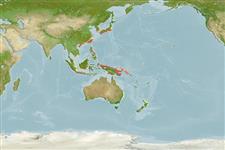>
Eupercaria/misc (Various families in series Eupercaria) >
Haemulidae (Grunts) > Plectorhinchinae
Etymology: Diagramma: Greek, diagramma = mark out by lines (Ref. 45335).
More on author: Cuvier.
Environment: milieu / climate zone / depth range / distribution range
Ecologia
marinhas bentopelágico. Tropical
Western Indian Ocean: Red Sea endemic and Socotra.
Length at first maturity / Tamanho / Peso / Idade
Maturity: Lm ?, range 32 - ? cm
Max length : 33.5 cm SL macho/indeterminado; (Ref. 5978)
Distinct pairing during breeding (Ref. 205).
Parenti, P., 2019. An annotated checklist of the fishes of the family Haemulidae (Teleostei: Perciformes). Iran. J. Ichthyol. 6(3):150-196. (Ref. 119443)
Categoria na Lista Vermelha da IUCN (Ref. 130435)
Ameaça para o homem
Harmless
Utilização humana
Ferramentas
Relatórios especiais
Descarregue XML
Fontes da internet
Estimates based on models
Preferred temperature (Ref.
123201): 19.7 - 29.1, mean 28.4 °C (based on 91 cells).
Phylogenetic diversity index (Ref.
82804): PD
50 = 0.5312 [Uniqueness, from 0.5 = low to 2.0 = high].
Bayesian length-weight: a=0.01950 (0.00846 - 0.04494), b=2.95 (2.75 - 3.15), in cm total length, based on LWR estimates for this (Sub)family-body shape (Ref.
93245).
Nível Trófico (Ref.
69278): 3.6 ±0.5 se; based on size and trophs of closest relatives
Resiliência (Ref.
120179): Médio, tempo mínimo de duplicação da população 1,4 - 4,4 anos (Preliminary K or Fecundity.).
Fishing Vulnerability (Ref.
59153): Low to moderate vulnerability (31 of 100).
